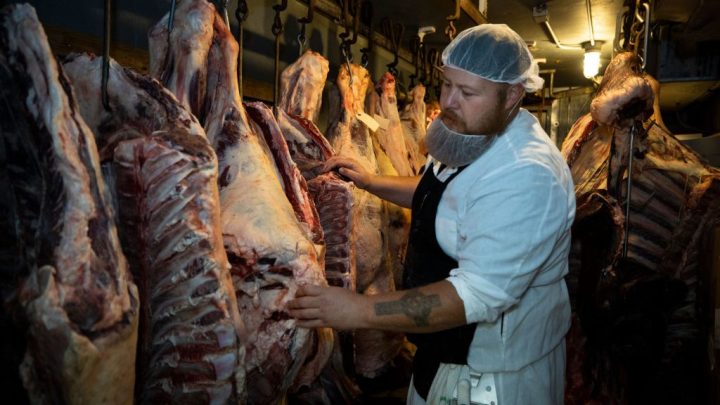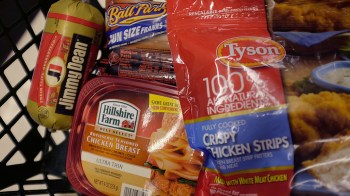
Consolidation has made the meat industry vulnerable to crises like COVID-19
Consolidation has made the meat industry vulnerable to crises like COVID-19

Early in the pandemic, commercial meatpacking plants became epicenters of COVID-19 outbreaks. According to a House panel report, over 59,000 meatpackers were infected and at least 269 died, causing some of the plants to close temporarily. The outbreaks upended the supply chain, leading farmers to dump a tremendous amount of meat; a report from the Family Farm Action Alliance estimated some 29,000 pounds of pork were destroyed.

Why was the meat supply chain so fragile? According to Forbes writer Chloe Sorvino, a lot of these issues came down to consolidation and how much control meat companies have over the markets. “The top meat packers [control] huge swaths of the industry,” said Sorvino in an interview with “Marketplace” host Kai Ryssdal. “You saw many meatpackers working hand-in-hand with state, local and federal government to keep plants open, to keep workers showing up on the line.”
In her book “Raw Deal: Hidden Corruption, Corporate Greed, and the Fight for the Future of Meat,” Sorvino looks at the environmental, economic and labor impact of consolidation in the meat industry, as well as what could be done to help make the industry more sustainable for the future. The following is an excerpt from the book, taking place just after the start of the COVID-19 closures.
In April, as potential shortages loomed, Temple Grandin called me from her home near Colorado’s ranchlands. Temple’s tone was gruffer than usual. The iconic slaughterhouse consultant had spent more than a half century pushing the biggest players in the meat industry—from McDonald’s to Cargill to Tyson—to adopt more humane livestock practices as they charted global expansion. Grocery stores hadn’t come this close to running out of burgers and bacon in decades.
My questions for Temple spilled out as I paced around my couch. The supply chain shocks were creating large amounts of waste. What was happening to the thousands of hogs not making it to the slaughterhouse? Why was the Department of Agriculture still reporting frozen beef and pork inventory nationwide at an all-time high? And why was meat still being exported while forty million people were unemployed and food bank lines lasted hours? Did Temple think industrial meat’s supply chains were broken beyond repair?
Badly managed is bad, Grandin decided, her deep and guttural voice punctuating each b. Big is not bad, she explained; it is fragile. Temple then told me the story of when she first realized this. During a storm in 2013, she was driving back to her Fort Collins, Colorado, home and the interstate was flooded. After finding the backroads also impassable, she continued to drive. She made it out near the town of Greeley, the agribusiness hub where JBS’s American division is headquartered. There, she found a massive feedlot where the cattle were all dry but the flooding was starting to hit the edges of the yard. A dry bridge came into view, just a foot out of water, and she drove over it to get home.
The bridge was submerged an hour later. JBS, the world’s largest meat supplier, had the infrastructure, but after that bridge flooded, the entire feedlot was at risk. The floods ended up lasting for a week, killing at least eight people.
“When big breaks,” Grandin told me, “you’ve got a real mess.”
It would have been harder for a disaster to strike if the cattle were spread apart, not just clustered in confinement at this one feedlot. Grandin’s tale remains a stark example of how the megaplants built in the past decade transformed the industry and have pushed it to the brink of centralization and efficiency. Since Grandin started her career designing cattle systems in the 1970s, she has become one of the few in the meat industry who have witnessed the entire arc of decades of consolidation—how the plants moved to the countryside, chasing after supersized feedlots that promised to make the industry more efficient, while the small ones left in cities got swallowed up or went bankrupt.
In the past fifty years, the number of US meatpacking plants has been cut in half. The cost of compliance for small, independent processors has eaten into already slim profits. Just 835 federally inspected slaughterhouses remain. Those plants had to get bigger to survive. About 60 percent of all beef and pork processing in 2015 came from the top thirteen plants in each industry. Smithfield’s Sioux Falls plant … is responsible for roughly 5 percent of the country’s pork supply, and slaughters at a rate of nineteen thousand hogs per day, across three shifts. This consolidation has created fragility, easily threatened by a crisis.
Excerpted from “Raw Deal” published by One Signal/Atria Books, a division of Simon & Schuster, Inc. Copyright © 2022 by Chloe Sorvino
There’s a lot happening in the world. Through it all, Marketplace is here for you.
You rely on Marketplace to break down the world’s events and tell you how it affects you in a fact-based, approachable way. We rely on your financial support to keep making that possible.
Your donation today powers the independent journalism that you rely on. For just $5/month, you can help sustain Marketplace so we can keep reporting on the things that matter to you.


















